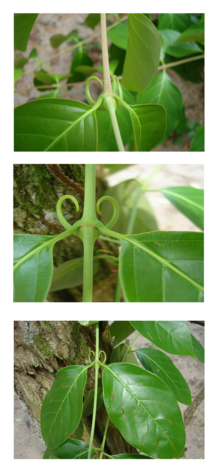Uncaria tomentosa
| Uncaria tomentosa | |
|---|---|

| |
| Scientific classification | |
| Kingdom: | Plantae |
| Clade: | Tracheophytes |
| Clade: | Angiosperms |
| Clade: | Eudicots |
| Clade: | Asterids |
| Order: | Gentianales |
| Family: | Rubiaceae |
| Genus: | Uncaria |
| Species: | U. tomentosa
|
| Binomial name | |
| Uncaria tomentosa (
DC.[1] | |
Uncaria tomentosa is a
Evidence anti-inflammatory action is limited to cell culture studies.[5][6] and has not been demonstrated in randomized control human trials.[citation needed] Cat's claw is being studied for a number of other possible uses, including HIV, Crohn disease, multiple sclerosis, systemic lupus erythematosus (SLE or lupus), endometriosis, kidney problems, bladder cancer, and Alzheimer disease. More research is needed before scientists can say whether it is effective.[7][8]
Description
Uncaria tomentosa is a liana deriving its name from hook-like thorns that resemble the claws of a cat.[2] U. tomentosa can grow to a length of up to 30 m (100 ft), climbing by means of these thorns.[1] The leaves are elliptic with a smooth edge, and grow in opposing pairs. Cat's claw is indigenous to the Amazon rainforest, with its habitat being restricted primarily to the tropical areas of South and Central America.[1]
Taxonomy
There are two species of cat's claw commonly used in North America and Europe, Uncaria tomentosa and
Phytochemicals
Traditional medicine
Cat's claw bark has been used as a traditional medicine in South American countries over centuries for its supposed health benefits, and is a common herbal supplement.[2][4][10] As of 2021, there is no high-quality clinical evidence that it has any benefit in treating human diseases.[2][4]
Interactions
Cat's claw has extensive interactions with numerous prescription drugs.[2] Its safety over long-term use or during pregnancy has not been scientifically determined.[2][4]
Adverse effects
Individuals
People requiring anticoagulation, blood pressure, or immune therapy should not use cat's claw.[2][4]
See also
- List of ineffective cancer treatments
References
- ^ a b c d "Uncaria tomentosa". Germplasm Resources Information Network. Agricultural Research Service, United States Department of Agriculture. Retrieved 2008-03-01.
- ^ a b c d e f g h i j k l m "Cat's claw". Drugs.com. 6 September 2021. Retrieved 16 August 2022.
- ^ "Assessment report on Uncaria tomentosa (Willd. ex Schult.) DC., cortex" (PDF). European Medicines Agency. 10 March 2015. Retrieved 11 January 2019.
- ^ a b c d e f "Cat's claw". National Center for Complementary and Integrative Health, US National Institutes of Health. 1 May 2020. Retrieved 17 August 2022.
- S2CID 24640166.
- S2CID 72216843.
- ^ "Cat's claw Information". Mount Sinai Health System.
- ^ Patel, Kamal. "Research Breakdown on Cat's claw". Examine.
- PMID 15070175.
- ^ a b c d "Detailed Scientific Review of Cat's Claw (archived)". M.D. Anderson Center. 31 May 2006. Archived from the original on 26 August 2013. Retrieved 10 January 2019.
- PMID 10075119.
- PMID 31643645.
External links
- Santa Maria, A; Lopez, A; Diaz, M.M; Albán, J; Galán de Mera, A; Vicente Orellana, J.A; Pozuelo, J.M (August 1997). "Evaluation of the toxicity of Uncaria tomentosa by bioassays in vitro". Journal of Ethnopharmacology. 57 (3): 183–187. PMID 9292411.
- Yunis Aguinaga, Jefferson; Claudiano, Gustavo S.; Marcusso, Paulo F.; Ikefuti, Cynthia; Ortega, George G.; Eto, Silas F.; da Cruz, Claudinei; Moraes, Juliet R. E.; Moraes, Flávio R.; Fernandes, João B. K. (2014). "Acute Toxicity and Determination of the Active Constituents of Aqueous Extract of Uncaria tomentosa Bark in Hyphessobrycon eques". Journal of Toxicology. 2014: 412437. PMID 24734041.
 Media related to Uncaria tomentosa at Wikimedia Commons
Media related to Uncaria tomentosa at Wikimedia Commons- Uncaria tomentosa List of Chemicals (Dr. Duke's Databases)
